
Twitter’s blue checkmark is now a status symbol. Elon Musk, who completed his purchase of the social media company for $44 billion on October 27, is charging Twitter users a monthly subscription for verification.
“Twitter’s current lords & peasants system for who has or doesn’t have a blue checkmark is bullshit,” Musk said in a tweet on November 1. “Power to the people! Blue for $8/month.”
Twitter Blue is essentially a premium version of the social media site, offering some perks like the ability to edit tweets, read ad-free articles, and customize the Twitter app icon. Musk’s updated Twitter Blue allows anyone who pays $8/month to get verified (and the blue checkmark).
Many Twitter users (verified or not) have questions about this change. Let’s try to answer them.
What does the new Twitter Blue subscription include?
For $8/month ($96/year), Twitter Blue subscriptions give “priority in replies, mentions & search, which is essential to defeat spam/scam,” according to Musk. Blue also gives subscribers the “ability to post long video & audio,” “half as many ads,” and “paywall bypass for publishers willing to work with us.”
This is on top of the previous features that let Twitter Blue subscribers edit tweets and customize their app icons. The ability to read certain articles ad-free was removed after Musk took over Twitter.
How much does Twitter verification cost?
$8 per month. Twitter verification is included in Twitter Blue’s monthly price.
Who can get verified?
Previously, blue checkmarks on Twitter were reserved for “an account of public interest” according to Twitter’s Help Center site. These accounts could be celebrities, journalists, influencers, politicians (like the U.S. president!), company brands, etc. Twitter could verify a user or a user could apply for verification in hopes of being granted the checkmark. The verification process was designed to prevent cases of mistaken identity online.
However, under Musk, anyone can now be verified so long as they pay for a Twitter Blue subscription.
Do previously verified users need to pay to keep their checkmark?
The Verge originally reported that non-Blue verified users would have up to 90 days to subscribe or they would lose their checkmark. If that was Musk’s original plan, he didn’t go through with it. From The Verge’s Alex Heath:
Musk was originally planning for Twitter’s paid verification subscription to require that existing verified accounts ALSO pay or lose their checkmarks. Now Twitter is saying that paid verification “will not affect existing verified accounts at this time”
So for now, the answer is no, non-Blue verified users will not need to pay to keep their checkmarks.
What if someone tries to impersonate you with a fake verified account?
That’s what everyone with a verified account wants to know. If anyone can pay for verification, what happens if a person pays to verify their username and uses it to impersonate somebody else who is verified or unverified? The whole point of verified users is that you are certain they are authentic.
For example, Inverse deputy editor Raymond Wong’s verified account is @raywongy. His account is verified so you know the account really belongs to him. But what if a stranger pays to verify, say, @raywongy2, and pretends to be Raymond? How is the public supposed to know which verified account is the real one?
There seems to be a lot of potential for abuse. On November 9, several fake accounts, verified with Twitter Blue, impersonated brands such as Nintendo and Valve, and celebrities like Lebron James. They were removed later, but this kind of scenario was exactly what we predicted would happen — and it did.
Musk originally proposed a separate label for public figures. “There will be a secondary tag below the name for someone who is a public figure, which is already the case for politicians,” Musk said in a tweet.
Twitter’s Esther Crawford revealed an “Official” label underneath a username on November 8:
A lot of folks have asked about how you'll be able to distinguish between @TwitterBlue subscribers with blue checkmarks and accounts that are verified as official, which is why we’re introducing the “Official" label to select accounts when we launch.
Not all previously verified accounts will get the “Official” label and the label is not available for purchase. Accounts that will receive it include government accounts, commercial companies, business partners, major media outlets, publishers and some public figures.
The new Twitter Blue does not include ID verification – it’s an opt-in, paid subscription that offers a blue checkmark and access to select features. We’ll continue to experiment with ways to differentiate between account types.
The “Official” badge didn’t last very long. On November 9, just as the “Official” badge was rolling out to select Twitter accounts including Inverse’s, Elon Musk killed the feature. “Blue check will be the great leveler,” Musk said in a tweet response to YouTuber Marques Brownlee.
Adding to the confusion, Crawford tweeted a clarification on the “Official” badge that completely contradicted Musk:
The official label is still going out as part of the @TwitterBlue launch -- we are just focusing on government and commercial entities to begin with. What you saw him mention was the fact that we're not focusing on giving individuals the "Official" label right now.
But before Crawford clarified that, Musk snuck in:
Please note that Twitter will do lots of dumb things in coming months. We will keep what works & change what doesn’t.
To which Crawford quote retweeted:
There are no sacred cows in product at Twitter anymore. Elon is willing to try lots of things -- many will fail, some will succeed. The goal is to find the right mix of successful changes to ensure the long-term health and growth of the business.
After a day of back-and-forth, Twitter finally settled on killing the “Official” badge altogether for all accounts. From the @TwitterSupport account:
We’re not currently putting an “Official” label on accounts but we are aggressively going after impersonation and deception.
Musk and Twitter brought back the “Official” label for select accounts starting on November 14 to combat impersonation.
One change that users have noticed: you can no longer add a checkmark emoji in your bio description; previously you could.
How to tell the difference between paid and non-paid verified users?
As of November 9, if you click on a user’s blue checkmark, you will see one of two options. For non-paying verified users: “This account is verified because it’s notable in government, news, entertainment, or another designated category.”

And for paid verified users: “This account is verified because it’s subscribed to Twitter Blue.”

Everyone is verified?
All of this makes you wonder: if everyone becomes a verified user, what value would verification even have? Verification is merely a status symbol. You can be verified because your account has some kind of public importance; you can pay for the checkmark via Twitter Blue; or you can not be verified at all.
Why is Elon Musk doing this?
Simple: money. Revenue. Profits. With shrinking year-over-year revenue, Musk needs to trim the fat and generate cash flow at Twitter. Musk says the new $8/month Twitter Blue “will also give Twitter a revenue stream to reward content creators.”
It’s not hard to see why Musk thinks it’s a genius idea to charge for verification. Twitter had around 400,000 verified users as of 2021, according to The Guardian. If every one of those users forks over $8/month, Twitter would bring in $38.4 million a year. With a reach of 237 million daily users, Twitter could make a theoretical $22.7 billion annually if every user paid for verification. Of course, not everyone will, so the revenue would be less, but it would still be a lucrative amount.







